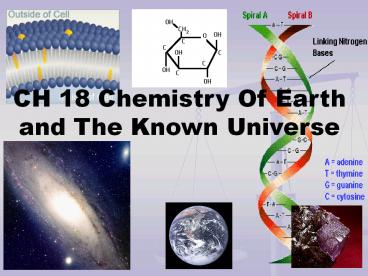Atomic Structure PowerPoint PPT Presentation
Title: Atomic Structure
1
CH 18 Chemistry Of Earth and The Known Universe
2
Atomic Structure Subatomic Particles
- Proton- P positive charged - in nucleus
- Number of P distinguishes one atom from another
- Made of 2 up quarks (2/3 charge) and 1 down
quark (-1/3 charge) - Neutron- No neutral charged - in nucleus
- Made of 2 down quarks and 1 up quark
3
Electrons
- Electron- e- negatively charged - swarming in
energy levels around nucleus of atom (electron
cloud).
Electrons (e-) are attracted to the positively
charged protons (P) in the nucleus, helping them
remain close to the nucleus in swarming levels.
4
Energy Levels
- Electrons e- have a specific amount of energy
when in each level. - K Shell has least energy
- M Shell has most energy (as far as were going)
- e- can occupy only 1 level at a time
- No matter how many levels the outer level
(valence) can have no more than 8 e- - Most stable atoms have 8 e- in valence
5
(No Transcript)
6
18.2 Comparing Atoms
- The number of P determines the type of atom.
- If you change the number of P you change the
atom.
7
18.2 Atomic Number
- The Atomic Number is total number of protons in
the nucleus of an atom.
8
18.2 Mass Number
- The total number of protons and neutrons in the
nucleus of an atom is called the Mass Number or
Atomic Mass.
9
18.2 Isotopes
- Isotopes are atoms of the same element that have
different numbers of neutrons. - Each of the below atoms are hydrogen, but they
are all isotopes of hydrogen.
10
Isotopes
- An atom can have 2 or more isotopes
- Isotopes have different numbers of neutrons
- Thus different mass numbers
- More N add mass to atom
- Heavier elements are radioactive (give off N)
11
(No Transcript)
12
18.3 The Periodic Table of Elements
- Elements are made up of only one kind of atom.
- Compounds are made up of combinations of atoms.
- Elements that are part of the same group act
alike.
13
18.3 The Periodic Table of Elements
- Dimitri Mendeleev (1834- 1907) organized
information about all the known elements in a
table that visually organized the similarities
between them. - Mendeleev placed each element on the table in a
certain row and column based on its properties.
14
- The chemical symbol is an abbreviation of the
elements scientific name.
PowerShow.com is a leading presentation sharing website. It has millions of presentations already uploaded and available with 1,000s more being uploaded by its users every day. Whatever your area of interest, here you’ll be able to find and view presentations you’ll love and possibly download. And, best of all, it is completely free and easy to use.
You might even have a presentation you’d like to share with others. If so, just upload it to PowerShow.com. We’ll convert it to an HTML5 slideshow that includes all the media types you’ve already added: audio, video, music, pictures, animations and transition effects. Then you can share it with your target audience as well as PowerShow.com’s millions of monthly visitors. And, again, it’s all free.
About the Developers
PowerShow.com is brought to you by CrystalGraphics, the award-winning developer and market-leading publisher of rich-media enhancement products for presentations. Our product offerings include millions of PowerPoint templates, diagrams, animated 3D characters and more.

